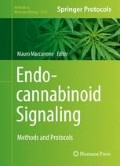Abstract
Cannabinoid CB1 and CB2 receptors are G-protein-coupled receptors (GPCRs) that recruit β-arrestins upon activation by (partial) agonists. β-Arrestin recruitment is induced by phosphorylation of their C-terminal tails, and is associated with the termination of GPCR signaling; yet, it may also activate cellular signaling pathways independent of G-proteins. Here, we describe a detailed protocol to characterize the potency and efficacy of ligands to induce or inhibit β-arrestin recruitment to the human CB1 and CB2 receptors, by using the PathHunter® assay. The latter is a cellular assay that can be performed in plates with 384-wells. The PathHunter® assay makes use of β-galactosidase complementation, and has a chemiluminescent readout. We used this assay to characterize a set of reference ligands (both agonists and antagonists) on human CB1 and CB2 receptors.
Access this chapter
Tax calculation will be finalised at checkout
Purchases are for personal use only
References
Rang HP, Dale MM, Ritter JM et al (2008) Rang and Dale’s pharmacology, 6th edn. Elsevier, Edinburgh
Hamm HE (1998) The many faces of G protein signaling. J Biol Chem 273:669–672
Shenoy SK, Drake MT, Nelson CD et al (2006) Beta-arrestin-dependent, G protein-independent ERK1/2 activation by the beta2 adrenergic receptor. J Biol Chem 281:1261–1273
Whalen EJ, Rajagopal S, Lefkowitz RJ (2011) Therapeutic potential of β-arrestin- and G protein-biased agonists. Trends Mol Med 17:126–139
Violin JD, Lefkowitz RJ (2007) Beta-arrestin-biased ligands at seven-transmembrane receptors. Trends Pharmacol Sci 28:416–422
Atwood BK, Wager-Miller J, Haskins C et al (2012) Functional selectivity in CB2 cannabinoid receptor signaling and regulation: implications for the therapeutic potential of CB2 ligands. Mol Pharmacol 81:250–263
Bosier B, Muccioli GG, Hermans E et al (2010) Functionally selective cannabinoid receptor signalling: therapeutic implications and opportunities. Biochem Pharmacol 80:1–12
Price MR (2005) Allosteric modulation of the cannabinoid CB1 receptor. Mol Pharmacol 68:1484–1495
Han S, Thatte J, Buzard DJ et al (2013) Therapeutic utility of cannabinoid receptor type 2 (CB2) selective agonists. J Med Chem 56:8224–8256
Zhang R, Xie X (2012) Tools for GPCR drug discovery. Acta Pharmacol Sin 33:372–384
Patel A, Murray J, McElwee-Whitmer S et al (2009) A combination of ultrahigh throughput PathHunter and cytokine secretion assays to identify glucocorticoid receptor agonists. Anal Biochem 385:286–292
Van der Lee MMC, Blomenröhr M, van der Doelen AA et al (2009) Pharmacological characterization of receptor redistribution and beta-arrestin recruitment assays for the cannabinoid receptor 1. J Biomol Screen 14:811–823
Van Der Lee MMC, Bras M, van Koppen CJ et al (2008) beta-Arrestin recruitment assay for the identification of agonists of the sphingosine 1-phosphate receptor EDG1. J Biomol Screen 13:986–998
DiscoveRx. http://www.discoverx.com/DiscoveRx/media/ContentFiles/DataSheets/93-0001L.pdf
Yin H, Chu A, Li W et al (2009) Lipid G protein-coupled receptor ligand identification using beta-arrestin PathHunter assay. J Biol Chem 284:12328–12338
Acknowledgements
The authors wish to thank DiscoveRx for their technical assistance.
Author information
Authors and Affiliations
Corresponding author
Editor information
Editors and Affiliations
Rights and permissions
Copyright information
© 2016 Springer Science+Business Media New York
About this protocol
Cite this protocol
Soethoudt, M., van Gils, N., van der Stelt, M., Heitman, L.H. (2016). Protocol to Study β-Arrestin Recruitment by CB1 and CB2 Cannabinoid Receptors. In: Maccarrone, M. (eds) Endocannabinoid Signaling. Methods in Molecular Biology, vol 1412. Humana Press, New York, NY. https://doi.org/10.1007/978-1-4939-3539-0_11
Download citation
DOI: https://doi.org/10.1007/978-1-4939-3539-0_11
Published:
Publisher Name: Humana Press, New York, NY
Print ISBN: 978-1-4939-3537-6
Online ISBN: 978-1-4939-3539-0
eBook Packages: Springer Protocols

